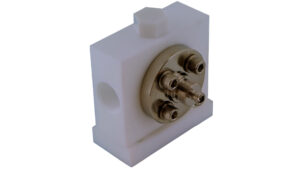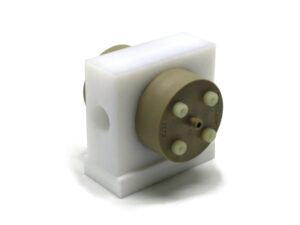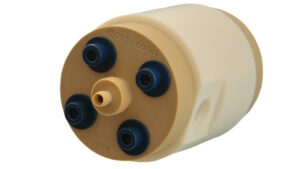Using a Teflon Flow Cell is a good choice when sample streams are either extremely corrosive or intolerant to metal contamination, as none of the cell’s wetted parts are constructed of metal. There are several variations of this inert flow cell design. Each type of Teflon flow cell has the same path length options as its metal counterpart.
Teflon Flow Cell for Corrosive Sample Streams or Metal Intolerance

The design of the Teflon Flow Cell allows only smooth Teflon and sapphire surfaces to contact the process stream. Corrosion resistant stainless steel is used in the outer cell construction to maintain a rigid, stable optical path length. It is also guaranteed by the manufacturer not to leak. Otherwise, the Teflon Flow Cell utilizes the same optical components as the popular Multi-Purpose Metal Flow Cell.
Teflon not only “cold flows”, but has a very large temperature coefficient of expansion. To maintain the all important pathlength, stainless steel rods are embedded in the Teflon body. The windows and other precision optics are held rigidly in place by these rods. Thus, preventing even the slightest change to the critical pathlength during the normal expansion and contraction that naturally occurs with Teflon products. The measurement accuracy of the stream is therefore never compromised due to this or any other phenomena.
If necessary, the cell can be completely disassembled for inspection or deep cleaning. The reassemble step is easily accomplished without changing the critical pathlength. In addition, the Teflon Flow Cell is equipped with a convenient clean-out port that provides access to the windows for cleaning without disconnecting fibers or plumbing.
Teflon Flow Cell Design Features
- Non-Corrosive
- High optical throughput for low noise spectroscopy
- Suitable for liquids and vapors
- Collimated beam for consistently accurate measurements
- Reproducible pathlength permits servicing in the field
- Compatible with 200 through 600 micron fiber
- O-ring sealed optics to prevent ambient moisture infiltration
- Excellent for Semiconductor Processes / Applications (optional Pillar Fittings are available)
- Compatible with a variety of fiber optic analyzers, according to fiber diameter and spectral range
Teflon Pathlengths and Operating Range
- Standard Pathlengths: 2, 5, 10 and 20 mm (other paths available by special order)
- Temperature Ranges: 0 °C to 150 °C
- Pressure Ranges: 0 to 100 psi
PFA/PEEK Teflon Flow Cell for HF Semi-Conductor Baths

The PFA/PEEK Flow cell was developed for environments that must be completely metal-free. It is most commonly used in semiconductor applications where acid vapors may be present. The Teflon PFA/PEEK Flow Cell was developed for sample streams that are incompatible with metal components, specifically HF semi-conductor baths. None of the cell’s wetted parts are constructed of metal. Only smooth Teflon PFA and sapphire surfaces contact the process stream. Corrosion-resistant PEEK is used in the outer cell construction to eliminate any possible metals contamination originating from this part. Other major components of the cell are Teflon PFA and Kalrez® 6375UP (ultra-pure) o-rings.
Since no metal parts come in contact with the liquid stream, the design is ideal for processes where even ppb levels of metal contamination can create serious problems, as in semiconductor fab etching and cleaning steps. The cell also performs well in the presence of extremely corrosive streams containing strong acids, bases, peroxides or halogenated compounds.
PFA/PEEK Teflon Flow Cell Design Features
- High optical throughput for low noise spectroscopy
- Suitable for liquids and vapors
- Collimated beam for consistently accurate measurements
- Reproducible pathlength permits servicing in the field
- Compatible with 200 through 600 micron fiber
- O-ring sealed optics to prevent ambient moisture infiltration
- Excellent for Semiconductor Processes / Applications
- Compatible with a variety of fiber optic analyzers, according to fiber diameter and spectral range
PFA/PEEK Teflon Flow Cell Pathlengths and Operating Range
- Standard Pathlengths: 2, 5,10 and 20 mm (custom paths available by special order)
- Temperature Ranges: 0 °C to 110 °C
- Pressure Ranges: 0 to 100 psi
Axial Teflon Flow Cell Sensitivity for Trace Metal Contamination

A Teflon Axial Flow Cell design is called for when pathlengths exceed 20 mm and small flow volumes are required. It is a convenient, compact, rugged sample interface that is easy to install. The standard Teflon Axial Flow Cell has non-wetted metal components. It is available with a Teflon (PTFE) body with Teflon o-rings and either sapphire or fused silica windows depending on the spectral range. Teflon seals prevent leakage and protect the flow cells vital internal optics. Other major components are polyether ether ketone (PEEK), glass or fused silica lenses, and non-wetted viton o-rings.
Teflon Axial Flow Cell Design Features
- Excellent for Semiconductor Process / Applications
- Non-corrosive, no metal design
- High optical throughput for low noise spectroscopy
- Suitable for liquids and vapors
- Collimated beam for consistently accurate measurements
- Reproducible pathlength permits servicing in the field
- Compatible with 200 through 600 micron fiber
- O-ring sealed optics to prevent ambient moisture infiltration
- Compatible with most fiber optic-based spectroscopic instruments, according to fiber diameter and spectral range
Teflon Axial Flow Cell Pathlengths and Operating Range
- Standard Pathlengths: 25, 50, 75 and 100 mm (custom paths are available by special order)
- Temperature Ranges: 0 °C to 150 °C limited by the o-ring material
- Pressure Ranges: 0 to 100 psig